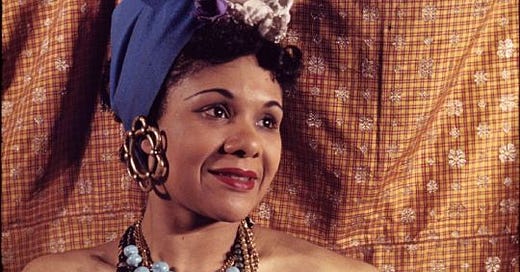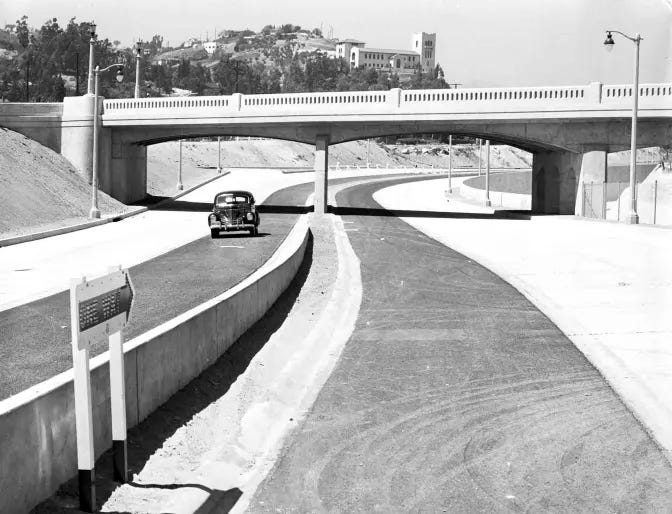Somnambulism comes naturally in Los Angeles. A somnambulist, or sleepwalker, is a person who moves in an unconscious state, lulled into a living trance. The perfect state for an inhabitant of a city where every day is a repetition of the day before and the day to follow. Perpetual crystalline sunshine, perfectly maintained swimming pools set in supernaturally green lawns; gliding onto the freeway, gliding off the freeway in a system of repeated motions. An intricate dance, where time passes and seems not to move at all. Ritual holds the mythology of the city together, bound by an endless circuit of echoes. A dream, a “ritual in transfigured time.”
When writer-filmmaker Maya Deren moved to Los Angeles in 1941, freeways had not yet scarred the face of the landscape, and her name was not yet Maya Deren. The first mile of the Cahuenga Pass Freeway in Hollywood was completed in 1940. The freeway, the first of its kind in Los Angeles, replaced a winding, almost rural road, which snaked between Hollywood and the San Fernando Valley. The new eight lane “superhighway” was a decisive monument to modernity and expansion, writ in asphalt and concrete: a literal restructuring of the natural order of the Santa Monica Mountains. Speed and the urgency of “progress” irrevocably replaced the natural experience of the California landscape. Now and ever after, virtually everyone in Los Angeles would be running on the same ritual schedule at top-speed, orchestrated by man-made design.
The interplay between natural order and mechanical design was a relationship which fascinated and vexed Deren in her creative and private lives (increasingly, there would be little distinction between the two). She was born Eleanora Derenkowsky in the city of Kyiv (present-day Ukraine) in 1907 to Jewish parents; her father Solomon Derenkowsky was a preeminent psychologist, and her mother was trained in the arts. As their only child, Eleanora was raised as a fusion of psychological study and creative impulse. In 1922, the Derenkowsky family was forced to flee Soviet Ukraine due to anti-Semitic pogroms perpetuated by the White Volunteer Army, an unofficial confederation acting in contra-distinction to “the Reds,” the revolutionary Red Army which supported the communist Bolshevik government.

Then only five years old, the tumult and trauma of the evacuation left a deep scar on Eleanora’s psyche; the disturbances of cultural disassociation and fractured identity would haunt her for the rest of her life. Almost immediately upon relocating to Syracuse in New York, Eleanora’s father changed the family name from Derenkowsky to Deren, and Eleanora Deren was reborn.
As she grew into a young woman, it is of little wonder why Eleanora gravitated to journalism and political science. Her early life had been shaped by political machinations beyond her control, and her identity made flexible out of the necessity for adaptability and fluidity, the instinct for survival. Out of trauma, she was a natural-born actress, adept at moving between selves in the performance of herself. As a writer, she could communicate and control her own sense of the world, conveying the truth of the experiences which felt so urgent to her. As a student at Syracuse University, she became active in the Young People’s Socialist League and a member of the Social Problems Club. Eleanora was seeking community through which to channel her conscience, her justified fury and grief, and her fervent hope for active social change. After a brief marriage and divorce, she studied at the New School for Social Research and then earned a master’s degree in English Literature at Smith College, an all-women’s college in Massachusetts. Always a force of nature, now armed with an education, Eleanora Deren was becoming formidable.
She moved to Greenwich Village, where she lived in a green tree-lined nexus of like-minded revolutionary thinkers and artists. Young James Baldwin lived in the Village then, as did the famous literary couple Dashiell Hammett and Lillian Hellman. Politics informed much of the creative conversations in the late 1930s and into the 1940s, emerging in theatre productions by Hellman on Broadway and by the Group Theatre, led by Greenwich Village resident Harold Clurman. Living on Morton Street in the Village, Deren supported herself through a variety of writing jobs, moving between modes of writing as if they were theatrical costumes. One day she was an assistant to Max Eastman (a “Village radical” and patron of the Harlem Renaissance), typing up his notes on communism and socialism, even as he moved from enthusiasm to critique. She then worked for William Seabrook, the notorious reporter and adventurer, most famous for his studies of occult “witchcraft,” his studies of West Africa, and his account that he had engaged in ritualistic cannibalism. These influences coalesced in Deren during these Village days and nights, and in the fertile realm of her imagination she created the artist she would soon become. She kept strange hours, writing barefoot, her dark curly hair in wild abandon around her face, moving across the wooden floorboards, standing to stretch, leaning out of the window into the humid night air of Morton Street. She kept the neighbors awake with the sound of her electric typewriter, writing with a possessed intensity as the editorial writing for which she was paid bled into her poetry, her collaged vision of her inner world. The thin walls of 61 Morton Street resounded with the ricocheting of Deren’s thoughts manifesting on the page, emerging from the urban cacophony. In her diary she wrote:
“Fire sirens screech, bells jangle, trucks backfire with the noise of an explosion, cats mate in the courtyards; in this house, there is other typing, at any and all hours, the front door slams shut with a bang all night long...”
Meanwhile uptown in the city, another kind of creative revolution was happening. A new musical was in the works, led by legendary choreographer George Balanchine who was ambitiously mounting his first production as both choreographer and director. Cabin in the Sky intended to put Black Southern life on the Broadway stage as a celebration of cultural heritage and folklore. Featuring an all-Black cast, the musical would present a stylized parable of Southern life and religion. Cabin in the Sky tells the story of a dying man, Little Joe, whose soul is caught between Heaven and Hell. Due to his faithful wife Petunia’s religious devotion and love, an ambassador of the Lord gives Little Joe six months to redeem himself; if he can end his sinful ways, Little Joe will go to Heaven. The Devil schemes to take back Little Joe, and he sends Little Joe’s former lover Georgia Brown to seduce him. As a story of love and redemption, hellfire and forgiveness, the play spoke to universal themes in a unique and highly stylized way.
Cabin in the Sky was born out of a European and Black creative team. George Balanchine, the director and choreographer, Vernon Duke, the musical composer, and Boris Aronson, the scenic designer, three of the most influential Broadway creatives of the 20th century, were all born in present-day Ukraine and Russia. Balanchine, born in St. Petersburg in 1904, is called the father of American Ballet; he created a neoclassical style that fused Russian dance tradition with the modern, musical dance he pioneered on Broadway and later in Hollywood. And yet, however pure their creative and social intentions, Balanchine, Duke, and Aronson were depicting a world they had never experienced firsthand: the Black American South. For the show to be based in reality and fully realized conceptually, Cabin in the Sky needed a creative collaborator who could educate the creative team and move between the worlds of dance and anthropology with knowledge, experience, and skill.
Enter thirty-one-year-old Katherine Dunham. Dunham was a singularly accomplished: a modern dancer, a choreographer, and an anthropologist. The youngest of two children born to Albert Dunham and Fanny June Dunham, Katherine had West African, Indian, French Canadian, and English ancestry. Growing up in early 1910s, Katherine experienced numerous hardships; her mother died when she was four years old, and her father left her and her older brother Albert Jr. in the care of an aunt in the South Side of Chicago. As a way of navigating the tempestuous circumstances of her early life, Katherine was drawn to creative expression and community involvement at a young age, founding a dance school for Black children while still in high school.
Dance was always the center of Katherine Dunham’s life, providing a channel through which she could transmute and explore her personal and ancestral history. As one of the first African American women to attend the University of Chicago in the early 1930s, she was fascinated by the connection between dance and social life, particularly in African American life. While at the University of Chicago, she created a new field of study within anthropology which she called “Dance Anthropology,” writing that Black Americans preserved and lived African culture through the ritual movement of dance. The study of dance as a living history was a profound breakthrough in the academic study of African culture and would be a pillar of Dunham’s creative work throughout her life.
By 1935, Dunham had formalized her groundbreaking ambition; she wanted to explore the relationship between religious ritual and dance choreography in the spiritual dances of the Caribbean, to witness and experience for herself how dance is manifested in the sacred rites and rituals of Haitian Vodou. By combining ethnographic fieldwork with her creative mind as a choreographer and dancer, Dunham would change the future of dance forever by honoring sacred tradition in modern choreography. By the time she was brought into the production of Cabin in the Sky as a co-choreographer with Balanchine, Dunham had researched dance and ritual in Haiti, Jamaica, Martinique, and Trinidad, and published a thesis titled The Dances of Haiti: A Study of Their Material Aspect, Organization, Form, and Function. As legendary a choreographer as Balanchine was, he was every bit the student of Katherine Dunham in their collaboration on Cabin in the Sky; she was the heart, soul, and intellect of the production. In addition to her foundational creative contributions, she starred as the femme fatale Georgia Brown, the woman sent to seduce Little Joe, the woman who moves between Earth and Hell according to her own power.
There is no doubt Eleanora Deren attended at least one of the one hundred and fifty-six performances of Cabin in the Sky at the Martin Beck Theatre on Broadway. In 1941, Deren wrote to Katherine Dunham as a fan of her work, and asked to be her personal assistant and secretary. Their meeting would mark the crossroads of modern theatre and dance, Vodou, and the creation of the avant-garde.
To be continued…















This is off to a promising start. The further I read the faster I wanted to read, which only occurs in the presence of writing that is quite good or quite bad. This being the former, I am looking forward to part 2 and everything that lies beyond.
What an absolutely compelling and fascinating essay. Your prose had such grace and flow. I thoroughly enjoyed the read, and the photographs complemented the text beautifully. That 1940 image by Kubrick of the couple on the fire escape has always been one of my favorites, but it had been years since I last saw it. Eager to read part two.